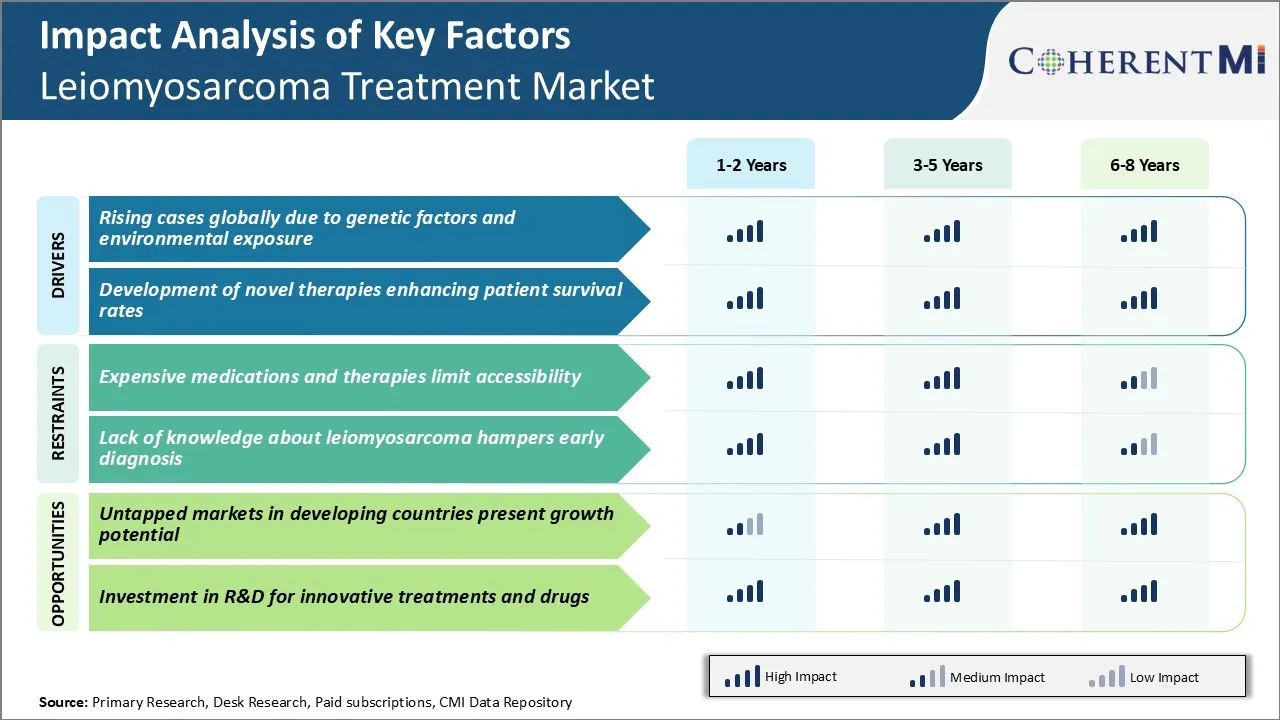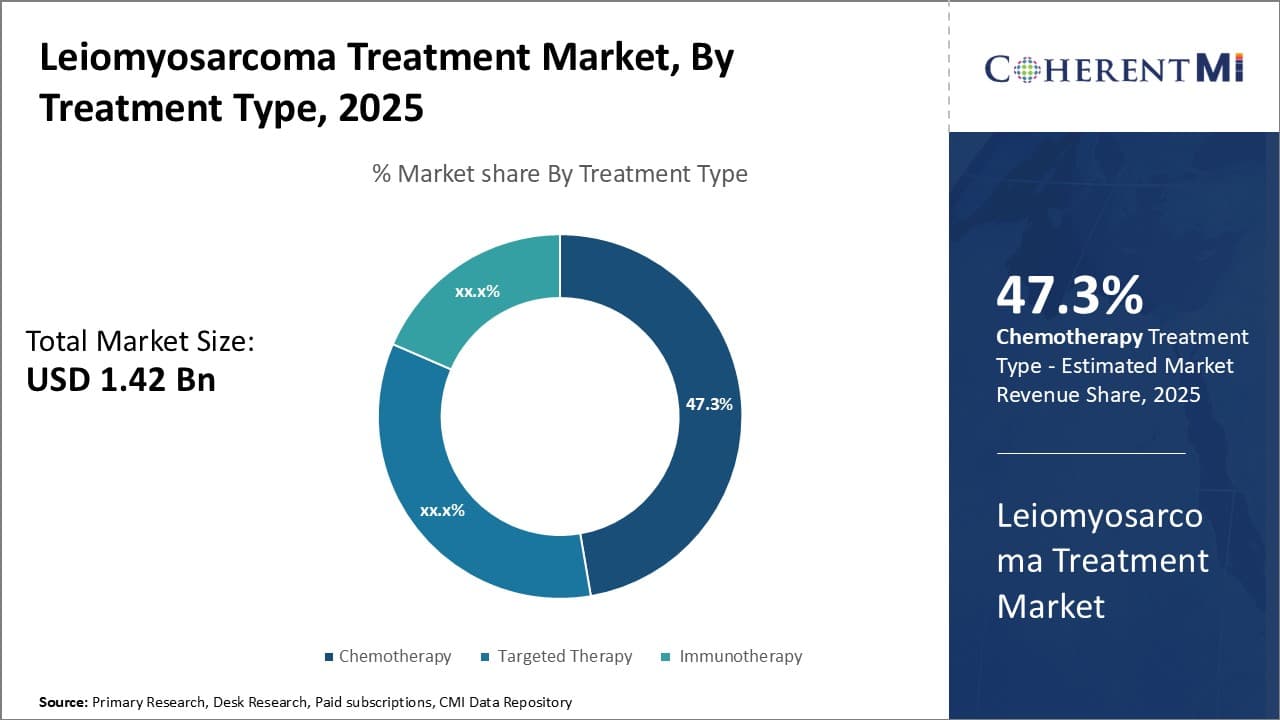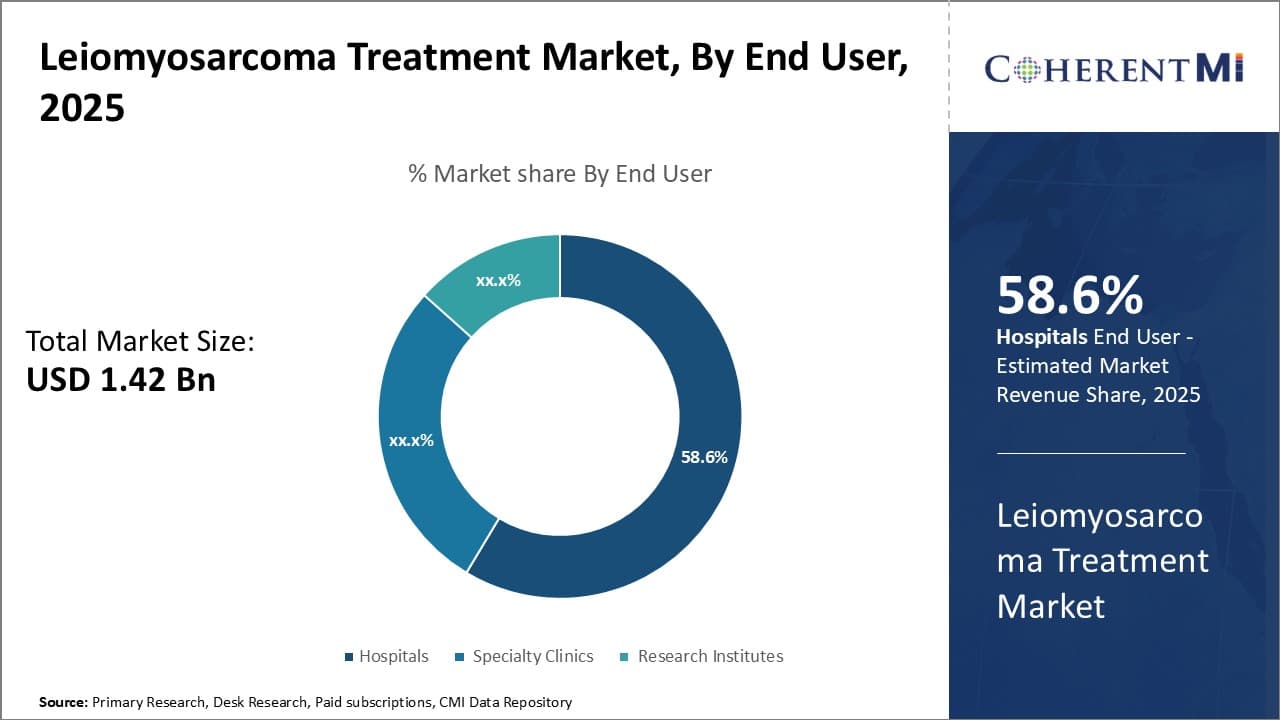

The leiomyosarcoma treatment market is estimated to be valued at USD 1.42 billion in 2025 and is expected to reach USD 2.63 billion by 2032, growing at a compound annual growth rate (CAGR) of 9.2% from 2025 to 2032. The market is primarily driven by increasing prevalence of leiomyosarcoma, rising healthcare spending, and improving access to diagnosis and treatment in developing countries.
Market Size in USD Bn
CAGR9.2%
| Study Period | 2025-2032 |
| Base Year of Estimation | 2024 |
| CAGR | 9.2% |
| Market Concentration | High |
| Major Players | Pfizer Inc., Novartis AG, Eli Lilly and Company, Bristol-Myers Squibb Company, Merck & Co., Inc. and Among Others |
Market Driver - Rising Cases Globally Due to Genetic Factors and Environmental Exposure
One of the prominent drivers augmenting the growth of leiomyosarcoma treatment market is the steadily rising disease prevalence worldwide. Leiomyosarcoma is primarily caused by an interplay of genetic and environmental influences. Prolonged exposure to certain occupational and environmental carcinogens. Industrial workers engaged in petrochemical industry, agriculture and maintenance occupations have demonstrated elevated susceptibility.
A family history of the disease can sway the likelihood as well. Furthermore, weakened immune system owing to medical conditions and clinical therapies raises vulnerability to leiomyosarcoma development.
Unfortunately, growing industrialization and urbanization over the past few decades have aggravated community-level exposure to aforementioned environmental risk factors on a global scale. Developing countries lacking stringent safety regulations have borne the maximum brunt. Additionally, increased lifespan and aging demography even in developed countries imply a constantly expanding pool of elderly population under threat.
All these factors combined have contributed towards steady rise in new leiomyosarcoma cases reported worldwide year-on-year. Notably, incidences appear to be climbing faster in low- and middle-income regions compared to developed markets on account of weaker preventive measures and delayed healthcare access. The mounting disease burden has strengthened the need for more advanced and effective treatment interventions to provide relief to the growing patient pool worldwide.
Market Driver - Development of Novel Therapies Enhancing Patient Survival Rates
Another key promoter for leiomyosarcoma treatment market is the ongoing research and success in introducing novel treatment methods with improved efficacy. Over the last decade, significant breakthroughs have been made in unravelling the molecular pathways involved in leiomyosarcoma pathogenesis.
A host of targeted agents interfering with growth factor signaling, angiogenesis and immune checkpoints have shown promise in early clinical trials. Some leading novel therapeutic candidates currently under research includes trabectedin, pazopanib and regorafenib targeting angiogenesis and tumor growth signaling. Additionally, immune therapies modulating body's immune response against cancer cells like PD-1/PDL-1 inhibitors have demonstrated effectiveness.
Preliminary data indicate these targeted and immune-based treatment options may help improve progression-free and overall survival when administered alone or in combination with existing standards of care. If ongoing phase 3 trials validate their safety and efficacy profiles, several novel systemic therapies are expected to receive regulatory approvals in the coming years. Their commercial introduction will go a long way in enhancing patient outcomes by curtailing recurrence, extending survival periods and providing newer lines of treatment after failure of first line therapy. This vastly improved treatment landscape raises hope of containing disease fatality rates over the next decade.
 To learn more about this report, Download Free Sample Copy
To learn more about this report, Download Free Sample Copy
Market Challenge - Expensive Medications and Therapies Limit Accessibility
One of the major challenges faced by the leiomyosarcoma treatment market is the high cost of available medications and therapies. Leiomyosarcoma is a rare type of cancer and available treatment options are very limited. The drugs approved by regulatory authorities for leiomyosarcoma treatment have a very high cost of therapy, sometimes running into hundreds of thousands of dollars for a full course of treatment. This makes the treatment unaffordable for many patients.
The cost burden of the disease pushes many patients into severe debt or forces them to discontinue the treatment mid-way. The high fixed costs associated with drug discovery and development are passed on to the customers in the form of high drug prices. This restricts a large section of patients from accessing the life-saving treatment options.
The lack of affordable generic alternatives in the market further exacerbates the problem. Unless newer low-cost treatment alternatives are identified, the issue of accessibility is likely to remain a major challenge constraining market growth.
Market Opportunity - Untapped Markets in Developing Countries Present Growth Potential for Market
One of the major opportunities for the Leiomyosarcoma Treatment Market lies in the developing economies which have largely remained untapped. While developed countries account for the majority of the current market share, factors such as growing healthcare infrastructure and increasing disposable income levels in developing nations are expected to drive future market growth.
Countries such as India, Brazil, China, South Africa and others present a huge market potential considering their large population bases and improving medical capabilities. However, awareness levels regarding leiomyosarcoma remain relatively low in the developing world compared to developed markets. With focused marketing and educational initiatives, significant headway can be made into previously untapped markets and new patient pools.
This will open up new avenues of market expansion and revenue growth for pharmaceutical manufacturers dealing in leiomyosarcoma drugs. Governments too have recognized the need to enhance cancer care delivery in lower income countries, which is likely to support market access and uptake in such regions over the coming years.
Leiomyosarcoma is an advanced form of soft tissue cancer that has multi-line treatment options depending on the stage and progression of the disease. In early stages (I-II), surgery to remove the tumor is the primary line of treatment. For late stage or metastatic disease (III-IV), chemotherapy is prescribed as the frontline treatment. Doxorubicin or gemcitabine alone or in combination with docetaxel are common first-line options. If the cancer progresses, pazopanib (Votrient) is often prescribed as the second-line treatment.
For patients who progress on or after chemotherapy, trabectedin (Yondelis) and eribulin (Halaven) are approved as third-line options in Europe. Clinical trials have shown that trabectedin prolongs progression-free survival and time-to-progression compared to dacarbazine. Another key factor for prescribers is the relatively better tolerability profile of trabectedin. Eribulin is also gaining acceptance as it has shown overall survival benefits in late-line settings.
Immunotherapies like pembrolizumab (Keytruda) are emerging as promising alternatives in pre-treated patients. Given the limited treatment options and high unmet need, prescribers actively consider enrollment in clinical trials evaluating new drugs. The response duration to prior therapies and tolerability profile strongly influences individual prescribing decisions.
Leiomyosarcoma can be categorized into localized, locally advanced or metastatic stages depending on the extent of disease spread. For localized disease, surgery remains the mainstay of treatment with negative margins being the goal. For tumors deemed unresectable, neoadjuvant (pre-operative) or adjuvant (post-operative) radiation along with chemotherapy may be employed.
The most common first-line chemotherapy regimen for locally advanced or metastatic Leiomyosarcoma is gemcitabine plus docetaxel. This combination has shown response rates of 25-35% along with median overall survival of 12.5-15 months in clinical studies. The drugs work by interfering with DNA and microtubule function to stop cancer cell growth and division. Common brands used are Gemzar for gemcitabine and Taxotere for docetaxel.
For patients who progress on first-line chemotherapy or are unsuitable for it, pazopanib monotherapy remains a standard second-line option. Pazopanib is a multi-kinase inhibitor targeting vascular endothelial growth factor receptors which promotes tumor angiogenesis. Its brand name is Votrient. Median progression-free survival with pazopanib is 4.6 months based on clinical evidence.
Trabectedin is another chemotherapy option for pre-treated metastatic disease. It works by binding to DNA and interfering with cell division. The brand name is Yondelis. Overall response rates of 9-16% have been observed in clinical studies.
Focus on targeted therapies: Major players like Pfizer, Johnson & Johnson have focused on developing targeted therapies for LMS treatment. In 2017, Johnson & Johnson's drug Votrient (pazopanib) was approved for advanced LMS. It targets VEGFR pathways which are important for tumor growth. This helped widen treatment options beyond traditional chemotherapy.
Acquisitions and partnerships: Companies have acquired smaller firms working on novel LMS drugs to gain access to their pipelines. For example, in 2020 Pfizer acquired Amplyx Pharmaceuticals to gain rights to fosmanogepix, an antifungal drug showing promise in LMS clinical trials. This expands their portfolio. Players also partner, like Bayer collaborating with Lafarge to develop ripretinib, an investigational tyrosine kinase inhibitor.
Clinical trials: Companies conduct late phase clinical trials to seek regulatory approvals. In 2021, Eli Lilly reported positive results from a Phase 3 trial of sintilimab plus pemetrexed/platinum chemo for pre-treated LMS. If approved, it will be a new first-line option. Similarly, trials are evaluating the potential of immunotherapies like pembrolizumab.
Awareness programs: Players run awareness and patient support programs. In 2018, Novartis launched a program to educate about symptoms and innovative treatment options for advanced sarcomas including LMS. This helped reach more patients and doctors.
 To learn more about this report, Download Free Sample Copy
Insights, By Treatment Type: Established Efficacy Drives Dominance of Chemotherapy
To learn more about this report, Download Free Sample Copy
Insights, By Treatment Type: Established Efficacy Drives Dominance of Chemotherapy
Within the treatment type segment of the leiomyosarcoma treatment market, chemotherapy accounts for the largest share. Doxorubicin in particular has long been the standard first-line treatment for leiomyosarcoma since it was shown to offer a response rate of 26% when used as a single agent in early clinical trials. Decades of clinical use have demonstrated doxorubicin's ability to slow tumor growth and prolong survival, making it the preferred option for both newly diagnosed and recurrent/metastatic cases.
While newer targeted therapies and immunotherapies hold promise, their roles are still being defined through ongoing studies. Pazopanib is the only FDA-approved targeted therapy for advanced leiomyosarcoma, but response rates have been modest at 11-13% and drug resistance often develops. Immunotherapies like pembrolizumab and nivolumab that activate the immune system against tumors are under evaluation, but no large randomized controlled trials have yet reported how they compare to standard chemotherapy.
Given chemotherapy's established performance supported by a wealth of long-term outcome data, oncologists routinely recommend regimens containing doxorubicin or gemcitabine as the foundation of initial leiomyosarcoma treatment. Until newer modalities unequivocally prove they can match or exceed chemotherapy's results, it will remain the mainstay first-line approach driving the segment's market share leadership.
 To learn more about this report, Download Free Sample Copy
To learn more about this report, Download Free Sample Copy
Insights, By End User: Institutional Expertise Makes Hospitals the Dominant End User
Within the end user segment for leiomyosarcoma treatment, hospitals account for the largest share due to their institutional expertise in managing rare cancers. Leiomyosarcoma is a uncommon soft tissue sarcoma, so individual oncologists or clinics may only encounter a few cases per year. Hospitals with specialized sarcoma centers see much higher patient volumes and are best positioned to stay abreast of the latest treatment protocols.
Sarcoma centers also have multidisciplinary teams including surgeons, medical oncologists, radiation oncologists, pathologists, and other specialists experienced in leiomyosarcoma's complex management. The coordination and resources of a hospital setting allow for comprehensive diagnostic testing, complex surgeries, combined modality approaches, and enrollment in clinical trials - all of which influence outcomes. Furthermore, hospitals can offer patients access to novel therapies sooner through industry partnerships and research programs.
While specialty oncology clinics play an increasing outpatient role, most leiomyosarcoma patients - especially those with advanced or recurrent disease - ultimately interface most extensively with hospitals for intensive treatments and management of complications. This institutional dominance in handling even the most difficult cases drives their position as the leading end user category.
Insights, By Diagnosis Method: Immediate Visualization Drives Preference for Imaging Tests In Diagnosis
Within the diagnosis method segment of the leiomyosarcoma treatment market, imaging tests such as MRI and CT scans account for the highest usage due to their ability to immediately visualize tumor extent and characteristics. Leiomyosarcoma manifests as masses or nodules that often arise in the abdomen, pelvis or soft tissues of extremities.
While biopsy provides the definitive diagnostic confirmation, tissue sampling carries risks of complications from an invasive procedure and may still not capture heterogeneous areas of tumor biology. Imaging allows surgeons to optimally target the biopsy while also mapping out operative approaches beforehand. Follow-up scans also play a key role in monitoring response to neoadjuvant treatments or detecting recurrence, as leiomyosarcoma has an inherent tendency for distant metastases that may not be detected by physical exam alone.
Newer technologies like PET scans provide functional data on tumor metabolism complementing anatomic MRI and CT data. However, widespread availability of specialized PET remains limited versus ubiquitous standard cross-sectional imaging machines. Based on their abilities to immediately and non-invasively profile the full tumor extent, imaging tests will remain the initial diagnostic cornerstone driving their segment's market leadership.
The major players operating in the Leiomyosarcoma Treatment Market include Pfizer Inc., Novartis AG, Eli Lilly and Company, Bristol-Myers Squibb Company, Merck & Co., Inc., GlaxoSmithKline plc, Johnson & Johnson, Sanofi S.A., AstraZeneca plc, and AbbVie Inc.
Would you like to explore the option of buying individual sections of this report?
Ghanshyam Shrivastava - With over 20 years of experience in the management consulting and research, Ghanshyam Shrivastava serves as a Principal Consultant, bringing extensive expertise in biologics and biosimilars. His primary expertise lies in areas such as market entry and expansion strategy, competitive intelligence, and strategic transformation across diversified portfolio of various drugs used for different therapeutic category and APIs. He excels at identifying key challenges faced by clients and providing robust solutions to enhance their strategic decision-making capabilities. His comprehensive understanding of the market ensures valuable contributions to research reports and business decisions.
Ghanshyam is a sought-after speaker at industry conferences and contributes to various publications on pharma industry.
Leiomyosarcoma Treatment Market is segmented By Treatment Type (Chemotherapy, Targeted Therapy, Immu...
Leiomyosarcoma Treatment Market
How big is the leiomyosarcoma treatment market?
The leiomyosarcoma treatment market is estimated to be valued at USD 1.42 billion in 2025 and is expected to reach USD 2.63 billion by 2032.
What are the key factors hampering the growth of the leiomyosarcoma treatment market?
The expensive medications and therapies limit accessibility and lack of knowledge about leiomyosarcoma hampers early diagnosis are the major factor hampering the growth of the leiomyosarcoma treatment market.
What are the major factors driving the leiomyosarcoma treatment market growth?
The rising cases globally due to genetic factors and environmental exposure and development of novel therapies enhancing patient survival rates are the major factor driving the leiomyosarcoma treatment market.
Which is the leading treatment type in the leiomyosarcoma treatment market?
The leading treatment type segment is chemotherapy.
Which are the major players operating in the leiomyosarcoma treatment market?
Pfizer Inc., Novartis AG, Eli Lilly and Company, Bristol-Myers Squibb Company, Merck & Co., Inc., GlaxoSmithKline plc, Johnson & Johnson, Sanofi S.A., AstraZeneca plc, and AbbVie Inc. are the major players.
What will be the CAGR of the leiomyosarcoma treatment market?
The CAGR of the leiomyosarcoma treatment market is projected to be 9.2% from 2025-2032.